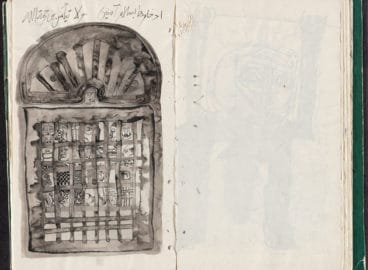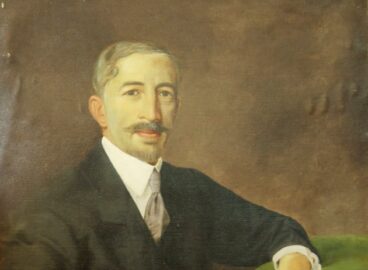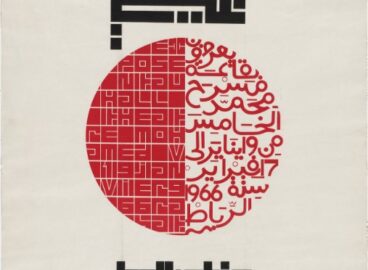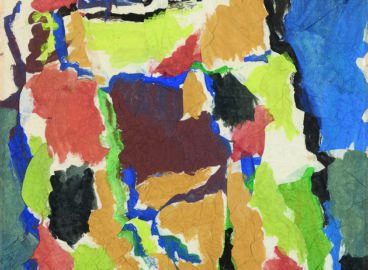The publication, Modern Art in the Arab World: Primary Documents (2018), edited by Anneka Lenssen, Sarah Rogers, and Nada Shabout, offers an unprecedented resource for the study of modernism: a compendium of critical art writings by twentieth-century Arab intellectuals and artists. The selection of texts—many of which appear for the first time in English—includes manifestos, essays, transcripts of roundtable discussions, diary entries, letters, and the guest-book comments including those featured here. Traversing empires and nation-states, diasporas and speculative cultural and political federations, the book’s documents bring light to the formation of a global modernism, through debates on originality, public space, spiritualism and art, postcolonial exhibition politics, and Arab nationalism, among many other topics. The collection is framed chronologically, and includes contextualizing commentaries to assist readers in navigating its broad geographic and historical scope. Interspersed throughout the volume are sixteen contemporary essays: writings by scholars on key terms and events as well as personal reflections by modern artists who were themselves active in the histories under consideration. A newly commissioned essay by historian and Arab-studies scholar Ussama Makdisi provides a historical overview of the region’s intertwined political and cultural developments during the twentieth century.
Below is a translation of the The Crystalist Manifesto.
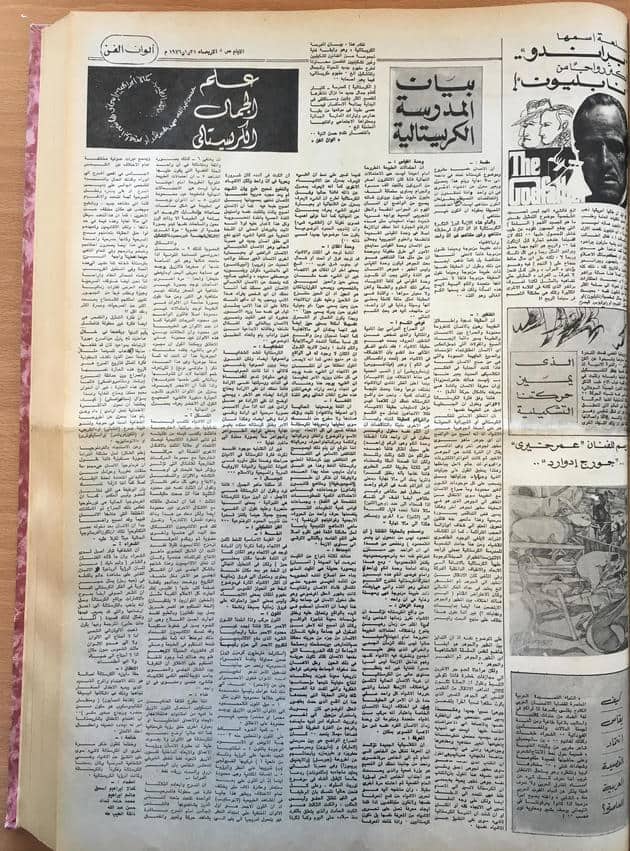
The Crystalist Manifesto
Authors Hassan Abdallah, Hashim Ibrahim, Kamala Ibrahim Ishaq, Muhammad Hamid Shaddad, Naiyla Al Tayib
Date 1976
Language Arabic
Introduction
Man himself is the endeavor and the subject of a crystal that extends endlessly within. This happens simultaneously in isolation from and in connection to other things. We believe that the contradictions inherent in the claim that the universe is finite are no less than the contradictions inherent in the claim that the universe is infinite. In the face of this crisis, the Crystalist idea emerges: the universe is at once finite and infinite; things have dual natures. When we say dual, we do not mean contradictory, for we go further and say that truth itself has a dual nature. When we refer to the duality of truth, we do not mean its multiplicity. This is not an issue that can be contained within a simple quantity; but perhaps it can be contained within a teleological quantity, namely, pleasure.
Theorization
Truth is relative, and absolute nature is dependent on man as a limited proposition. The struggle between man and nature always tries to find forms and claims for the opposite, that is, the absolute man, face-to-face with the limited forms and institutions in nature, which are themselves man-made. If the dialectic in classical modern thought is expressed with the phrases there are no isolated phenomena and man’s knowledge of matter lies in his knowledge of the forms of that matter’s movement, then we, in accordance with the idea of the crystal, may venture that the dialectic is a substitute for nature itself. The basic premise for Crystalist thought, or modern liberalism, is to reject the essential quality of things, for it is now clear that any essence is nothing but a semblance for another essence. In the past, it was said that the atom was the irreducible essence, but then a whole world was discovered within it—nuclei, electrons, protons. This applies to subatomic particles, sub-subatomic particles, and to the limitless forms of existence of the entire cosmos. Man’s struggle with nature is but a transition from semblance to essence, which is in turn a semblance for another essence, and so the undoing of contradictions continues endlessly. This is what we mean when we speak of the transition from the opaque to the transparent, i.e., the removal of layers of concealment. The discovery of atoms does not negate the surface existence of things. Hence the naming of our school Crystalism, which implies the existence of both the semblance, or form, of the crystal and the dimensions and spectrums perceived within it. In the past, the transition from semblance to essence, and then to semblance, and so on, was regarded as idealistic thought, the standing objection being: Is there no difference between semblance and essence? And does that not also entail a beginning and an end? To that we say: The difference is primarily one of research methodology, and that the differentiation between semblance and essence is also subject to the same infinite sequence: semblance, essence, semblance, essence. . . .
But in order not to drag others into precarious territory, we opt for simplification and describe the process as follows: the transition is from relative semblance to relative essence, which creates another relative semblance that contains a new essence, and so the undoing of contradictions continues. Furthermore, the idea itself, as well as objections to it, are ultimately nothing but a potential embodiment of the crystal in its infinite spectra and its semblances, themselves also subject to endlessness. It is self-evident that a book lying before its owner is nothing but a semblance of a deeper essence, but we would here add that the same book is an essence for the semblance that surrounds it. That is to say, the crystal not only moves forward but also extends backward. To be more precise, it moves in all directions, or in all of space; or, if you will, the Crystalist school is nothing other than a negation of the objectification of objects.
The Unit of Measurement
The possibilities that nature lays before our eyes are not the ultimate possibilities. When an electron is two thousand times smaller than a proton, and one gram measures six hundred million trillion protons, it is understandable that a human being today—with disparate senses and a simple, empirical mind—would feel extremely alienated when attempting to grasp such massive numbers. We believe that the crisis lies originally in the old unit of measurement, for philosophy and the empirical sciences make man the unit of measurement, which leads to a dead end. The solution to this contradiction is to resurrect the essence, not the semblance, as the unit of measurement. Man’s essence is pleasure, and that should be the sole unit of measurement everywhere, including in the sciences, philosophy, and art—there is no other criterion. Pleasure in fact represents a full circle, in the sense that it is both a means and an end. Our goal is to seek out the teleological quantity.
The Chaos of Quantity
The dramatic struggle between materialism and idealism has resulted in familiar theories regarding the reality of things. Since antiquity, idealist thinking has claimed that the difference in things lies in expansions and contractions in quantity, and that, per Pythagoras and Democritus, numerical proportions are the basis of differences between things. Materialism, on the other hand, declared differences between things to be qualitative and occurring as a result of quantitative accumulation. From the crystal’s perspective, we believe that neither of these approaches sufficiently grasps the reality of things, for both deal with quantity and accumulation as fixed realities rather than a reality full of myriad contradictions. Quantity itself is simultaneously rational and irrational. Taking, for example, the number one as a unit of quantity, we find that it is made up of an accumulation of three thirds. But if, for the sake of precision, we divide it decimally by three, we unexpectedly find the result to be cyclic fractions that extend into infinity, which means that the accumulation in the number one is irrational, for it is both finite and infinite. Furthermore, when one is divided by an even number—for example, two—we find that the result is infinitely divisible by two. We are confronted with the truth of the statement It is irrational for the finite to contain the infinite. We conclude that the number 1 is an irregular accumulation that, despite its finiteness, contains infiniteness. But we are still faced with the quantitative unit of “one.” In response to this quantum chaos, Crystalist thought emerges and proposes the teleological quantity, which is pleasure, and which also has a dual nature, being simultaneously a means and an end.
The Unit of Time
From the perspective of the crystal, we assert that things produce their own time, that there is more than one time depending on the diversity and difference of nature’s possibilities, and that what we live in is not that mythical collective time supposedly agreed upon by all people and shared by all things. Understanding the interconnectedness of multiple times is not particularly difficult, but it does require a high level of Crystalism. Man’s current alienation does not lie in the discrepancy of public times produced separately by separate things, but rather in the discrepancy of personal times, considering that each person is a construct of multiple and diverse things. The time unit of the individual is a matter of utmost importance.
Knowledge
Neoclassicism asserts that knowledge moves from the specific to the general, then back to the specific. We believe that generalization is a domain of repression. What really happens is that the specific and the free are pulled into the general domain and then returned in chains. We aim to liberate things from the repression of knowledge itself. To say that we seek knowledge that liberates things from knowledge itself does not make us self-contradictory; it makes us Crystalists. If knowledge was once based on the paradigm that a thing cannot be known in isolation from other things or from itself, then what we are currently proposing, in accordance with Crystalism, is that a thing cannot be known in isolation from infinity, or, in other words, that a thing can only be known in isolation from finiteness. We attach great importance to the claim that nothing is something, and that the dissolution of objective boundaries is itself a new objective boundary.
The Unit of Space
Matter exists in space. Things can exist above or below, to the North or the South, to the East or the West, etc. In other words, space is direction. But a thing is itself a space in the sense of an area, and area is determined by specificity, meaning that it would be difficult to claim that space is area, since area is extracted from the absence of area. We therefore say that when direction is specified it should be called an area, or, in other words, when it is perceived it should be called an area. Hence, North or East are also spaces in the sense of areas, except that they extend infinitely and are relative; indeed, infinite extension is possible from any relative point. Quantity is corrupt! We do not mean to claim that space does not exist in reality, but rather that it is an intellectual methodology. Based on the idea that space is direction, it is possible to say that the thing itself exists everywhere and, to complicate matters further, that the thing exists here and there in the same direction. In the face of this chaos of space, we propose teleological space, which is pleasure.
Language
Language, in its current state, being extremely close to objects, demonstrates its own corruption. The only way out of this is to dissolve language and turn it into a transparent crystal that moves in all directions: between the name, the subject, the thought, and their components; between the word and its components; and between the letter and its components. We expect this to happen in such a way that the fundamental opposition in language becomes an opposition between the crystal of meaning and the crystal of vocalization, which is a first and necessary step. We should mention here that the science of semiotics, [Claude] Shannon’s information theory, the methods for measuring quantitative possibilities of all information contained in a vocalization, the methods of measuring the information contained within one letter of the alphabet, and all associated mathematical laws—are nothing but dry academic methodologies as far as the problem of language is concerned. They are all based on the corrupt notion of quantity, and so do not rise to the level of the crisis.
Community
There are three types of repression suffered by the human form. Seen from a modern perspective, the first type is the repression that started with the separation of organic and inorganic matter, leading to the creation of man. The second type is the emergence of the objective mind, which is the mind of man’s entry into community. We also concede that at first, man collided with reality and outwitted it by creating certain institutions to fight it. It was inevitable, then, to form a community, and accordingly, man gave up a portion of his freedom in order to achieve harmony between his individual interests and the community’s interests. At the time, this price he paid was almost a freedom in itself. Ever since entering into community, man has been confronted with certain historical epochs characterized by different production relationships that were adopted by the intellectual institutions of each epoch, all confirming that instrument of repression. But the truth we are now facing is that the repression that occurred with the emergence of the objective mind continued to be inherited from one generation to the next. The idea of behavioral inheritance has much to support it, despite its being intentionally neglected for a long time. The obvious battle was between the schools of [Jean-Baptiste] Lamarck and [Charles] Darwin on the one hand, and those of [Hugo] de Vries and [August] Weismann—with their germ-cell research and evening primrose discoveries—on the other. In recent times, McDonough1Eds.: It is uncertain to whom the authors are referring with “McDonough” (or in Arabic “Makdunat”). came up with the decisive response to the question of behavioral inheritance. In all cases, we currently adhere to the idea that the function creates the organ and not the other way around. The third type of repression is the ongoing repression that is linked to the individual from birth to the present moment. As mentioned earlier, repression at first was both a necessity and a form of freedom, but through the acquisition of characteristics and its normalization, things become one’s nature, so that repression is no longer a price that man paid that ends with the end of its causes, but has become a human characteristic. Furthermore, man now finds pleasure in repression itself, having replaced sensual pleasure with nonphysical pleasure. There would be nothing wrong with that had the insufficiency of abstract pleasure not been scientifically proven. This has led to the creation of a new man for this age, the indifferent man, the refusing man, the man who does not experience pleasure. Modern literature, from Albert Camus’s “stranger” and Colin Wilson’s “outsider” to Tayeb Salih’s character Mustafa Sa‘eed, speaks of the indifferent man, the man who does not experience pleasure. We believe that anyone who reads such literature and appreciates it also carries a similar current within him. The risk is magnified by the fact that the undoing of that repression and the liberation of man, and thus all forms of his creative activities and energies—arts and literature—would be achieved by negating the objective mind.
Transparency
Crystalism seeks transparency, and so does Sufism, but the difference between the two can be summarized as follows: while Sufism (a mode of behavior) calls for dissolving into the self by negating personal volition, we believe that negating personal volition itself requires volition, or, in other words, that negating volition is itself a volitional act. When continued infinitely—volition, negation, volition, negation, and so on—an extending, infinite crystal is created, which again means the endlessly extending presence of semblances and essence. But similarities do exist: the idea of the crystal is mentioned, both explicitly and implicitly, in a number of religions, for example Manichaeism, Orphism, Christianity, and Islam.
Beauty
In response to the question of what beauty is, we say that the crystal represents utmost beauty, and that the most prominent quality of the crystal is its liberality, in the sense of its being liberated. Furthermore, we maintain that a thing becomes beautiful when it has acquired a certain measure of dissolving objective limitations.
Plastic Art
Line: The basic value of the line lies in its direction. As mentioned earlier, matter exists in a direction, which is space, and matter is itself space in the sense of area. But in the final analysis, a line is a dynamic spatial dimension that contains temporal differences and transforms into them. The most exciting things about the line are its tangible bias toward the concept of space as direction rather than as area, and its containment of simple and dynamic temporal differences.
Color: Color is a composite. Taking for instance the color red, we find it to be unlimited both positively and negatively. This has prompted academics to break it down into principal bundles—scarlet, vermilion, crimson, and rose—in a desperate attempt to contain its limitlessness. To make things easier, we call for a change in the names of colors, so that instead of red we would say redness. Furthermore, there are numerous principal factors that negate the limitedness of color, such as:
The inclination of unlimited color toward other colors, [as] blue exists in reddish or greenish tones, in utterly limitless variations.
The amount of light falling on a color and reflecting off it.
The proportion of whiteness or blackness in a color.
The eye’s capacity to see, taking into consideration: a) the eye’s physiological makeup; b) the eye’s training in seeing and perception.
Spatial distance, which is also limited. Color is completely different, depending on whether it is one centimeter away or ten thousand meters away. This can be clearly discerned in natural landscapes, where the color red is the first to fade, turning gradually to brown until it disappears.
Also, the psychological state of the viewer, which can simultaneously be both certain and doubtful.
The possibilities of the nature of color presented before us at any given moment are not final, for the colors of nature are limitless.
Colors exist in nature in the form of surface. It follows that no surface in nature is without a specific color. Areas themselves appear geometrically or organically. Once again, geometric forms are limitless, as are organic forms.
Another relative factor for the surface of a color, if its form is defined, is its size. Blue, for instance, can exist in an area as wide as the sea, or it can cover just one millimeter. Again, there are no limits to how big or small an area can be. This leads us to unequivocally assert that colors exist in nature in limitless forms and possibilities: each color has limitless tonalities, the number of colors in nature is limitless, and the relationships among colors are limitless. It can be said that simply being aware of a thing causes it to lose its essential characteristic, provided it had one to begin with. In this regard, Mao Zedong says that to know the taste of an apple you must taste it, meaning that you must change its taste in order to know it. Saying that green cannot be known in isolation from other colors would be an incomplete claim. The truth is that green can be known in isolation from finiteness.
Form: Objects acquire plastic value from their external movement: the value of a triangle lies in its triangularity. The academic perspective then studies the affiliations or relationships of a triangle with regard to other related forms, i.e., its external movement within the set of external movements of forms that it influences, or by which it is influenced. Aspects of similarity, balance, sequence, rhythm, and the rejection of disharmonies are studied. We assert that the triangle itself is of unlimited triangularity, assuming the validity of its reality as a triangle. The possibilities of its relationships with other forms are also unlimited. But let us forget all this and return to the academic perspective, where forms have always been divided into geometric and organic. Then, as knowledge progressed, academics had to budge a little, for it was proven that organic forms are only the product of geometric accumulations. As for geometric forms, those were eventually relegated to the museum of history with a massive sign that read “Euclid.” The old dreams have all collapsed—that two parallel lines never meet, that a straight line is the shortest route between two points, and the most impregnable stronghold of all, that light moves in a straight line. The old academics clung to these for a while, believing that an equivalent of the straight line existed in nature. But modern physics showed no mercy for any of these beliefs, and now the straight line no longer has any existence whatsoever. The differentiation between geometric and organic forms was a result of a quantitative understanding of things, but in reality everything is simultaneously geometric and organic.
An Appeal
We call on all plastic artists to use the color blue, for it has great potential in showing internal dimensions and depths—in other words, it has the ability to create a Crystalist vision. It is currently the clearest embodiment of Crystalism within the color spectrum. We must stress that the human ability to see internal dimensions in the color blue is not merely the result of a conditional reflex specific to the blueness of the sea and the sky.
Drama
The idea of the three dimensions of theater is irrational, for each theatrical performance is as multiple as the people who watch it. Someone sitting in the first row sees movements, expressions, and emotions, and hears vocal tones that are all completely different from what someone sitting at the very back of the theater, or to the right or left of the stage, sees and hears. So with the arrival of each new audience member, who would naturally occupy a different seat from all the others, a play remains open to further plurality and division. This plurality goes on infinitely, which is valuable in and of itself. But academics, with their habit of twisting the truth, deal with each play from a singular view, and it is on this basis that they issue their judgments, criticisms, and interpretations. Last year, when we covered the front of the theater with a transparent crystal, we were referencing this affliction. In the near future, in an attempt to ease critics’ consciences and give ourselves some rest, we will be interrupting the performance for short intervals in which we will ask audience members to change seats so that they can enjoy a greater variety of plays and have a more pleasant experience. This should result in less criticism. The idea of acting, or characterization, is itself an irrational idea: for two hours an actor can wreak havoc in the world through his assumed character, before hurrying off the stage for a previously arranged appointment, a cinema date for instance. This irrationality is not something that we discovered; the very history of theater is built on it. The struggle between theater giants like [Bertolt] Brecht and [Konstantin] Stanislavsky reflect it, and a dialogue with them is quite possible. Let us start with Stanislavsky’s question, “How can affective memory be turned into deliberate action?” And can this be achieved in isolation from the thesis of transparency? Is there not a need—even a minor one—for a theater of telepathy, history, clairvoyance, psychiatry, or automatism? Concerning the appeal to morphology (the science of form) to provide a futuristic solution to the problem of drama, we say that human morphology is a set of developmental cycles and multiple adaptations to ensure survival. We still maintain that it is the function that creates the organ and not the other way around. Furthermore, present morphology reflects that struggle that relates to the different capacities of an earlier age. Now that man has entered the technological age, present morphology has become almost a burden on him.
Poets
Transparency is a genuine current in poetry. What artist and poet William Blake said about man’s four-dimensional vision—the ability to see an entire world in a grain of sand—represents a cornerstone of Crystalist thought. Sufi poetry is also full of references to the reality of the crystal. Indeed, it takes the crystal to its furthest and most impenetrable extremes. This can be seen in the following translation of a poem by Asif Jatt Halabi:
The colors went to the sun I need neither colors Nor the absence of colors The suns died, devoid of space I need neither light Nor darkness
Children
The interest and intense joy that young children exhibit toward the crystal in its simple forms—like a soap bubble or a kaleidoscope, which consists of a lens and broken bits of glass—add to the crystal’s authenticity. Children’s interest in the crystal is a deeply complex matter, for children are the most complex of riddles.
Conclusion
We conclude by repeating that the crystal is nothing but the denial of the objectification of objects. It is infinite transparency. We painted the crystal, we thought about the crystal, and so the Crystalist vision came to be.
—“Bayān al-Madrasa al-Krīstāliyya,” al-Ayyām, January 21, 1976; repr. in Ṣalāḥ Ḥasan ʿAbd Allāh, Musāhamāt fī al-Adab al-Tashkīlī, 1974–86, 2nd ed. (Khartoum: Madarek, 2010), 311–22. Translated from Arabic by Nariman Youssef.
- 1Eds.: It is uncertain to whom the authors are referring with “McDonough” (or in Arabic “Makdunat”).
